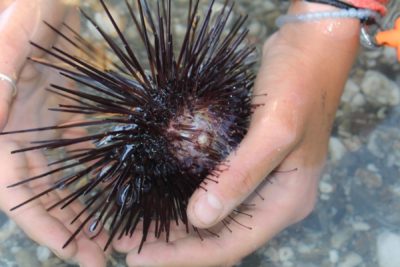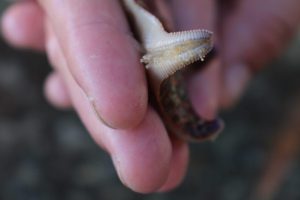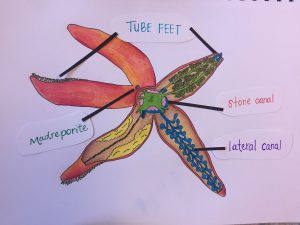
How do all of these spiny creatures move around? What’s the secret behind of all those tiny, squishy legs underneath? First, you must know that those little legs aren’t legs at all. If you were to examine the underside of a sea star, also known as the oral side (where the mouth is located), you would see rows and rows of tube feet. Tube feet are used for locomotion for most echinoderms. The phylum that groups together sea stars, sea urchins, sea cucumbers and many others of similar kind is called Echinodermata, translating to “spiny skin.” All echinoderms possess spiny skin, operate on a water vascular system, and can regenerate arms, or even digestive systems in some sea cucumbers.
 Here is a closer look at the tube feet of a Bat star!
Here is a closer look at the tube feet of a Bat star!
This is the oral side (underside where the mouth is located) of a Bat star! Here you can see the 5 arms of the creature and the rows of tube feet inside each one.
 For most echinoderms, the tube feet are the primary link between the water vascular system and the outside world. Water vascular system means instead of blood, like most animals, these creatures have water running through their body to help with all their movements.
For most echinoderms, the tube feet are the primary link between the water vascular system and the outside world. Water vascular system means instead of blood, like most animals, these creatures have water running through their body to help with all their movements.
On the top of a sea star, sea urchin or other echinoderm, there is a small round portal called the madreporite. The madreporite brings water inside the body of the animal. Inside the animal, there is a network of canals that send water through the body. If you didn’t know already, echinoderms possess pentaradial symmetry, meaning that there are five identical arms extending from one central disc! On each arm, there can be up to hundreds of tube feet.
 If looking at the picture of the sea star, you will see the internal canals and how on each arm the canals end at the tube feet. Once a sea star sucks in water through the madreporite (hole on top), the water then travels through all the tunnels to each arm of the creature. Within each arm, the tube feet use the pressure of the water to move over surfaces. Not only do the tube feet provide excellent, fast movements but they are also used for powerful suction when pulling apart shells of prey!
If looking at the picture of the sea star, you will see the internal canals and how on each arm the canals end at the tube feet. Once a sea star sucks in water through the madreporite (hole on top), the water then travels through all the tunnels to each arm of the creature. Within each arm, the tube feet use the pressure of the water to move over surfaces. Not only do the tube feet provide excellent, fast movements but they are also used for powerful suction when pulling apart shells of prey!
For example, the common starfish will use tube feet to pry apart the shells of oysters and mussels to get the mushy insides. Another example is the feather star, which will raise its arms, wave its tube feet around, and catch plankton to bring towards the mouth on the underside. Unlike sea stars and sea cucumbers, the common sea urchin has a beak that it uses for scraping algae off rocks. Instead of using tube feet as a function for capturing prey, urchins mainly use the tube feet as a means of transportation or quick retreat.

Written by: Madison Eggenberger


